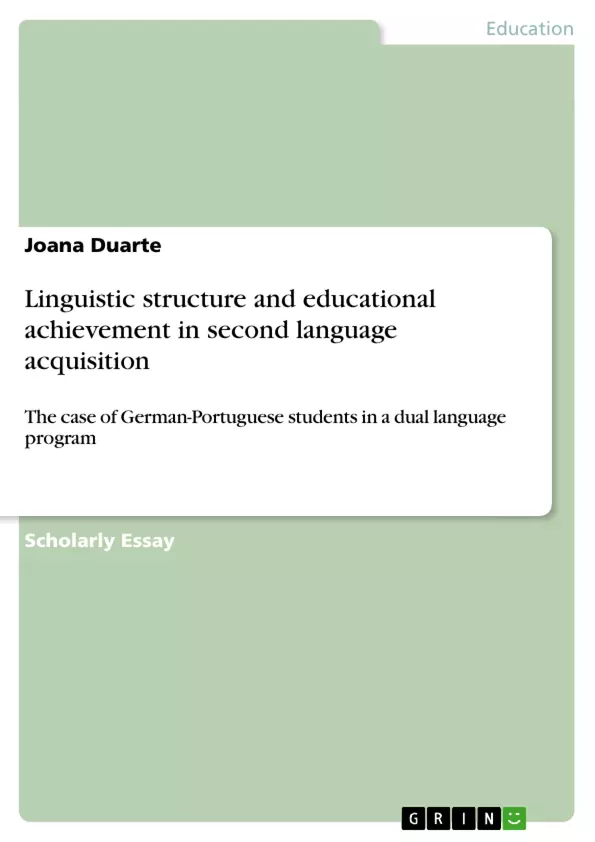The widely decontextualised educational language, its abstraction from everyday relations and its exemption from personal-dialogical communication have lead the Canadian researcher Jim Cummins to distinguish between „basic interpersonal communication skills“ (BICS) and „cognitive-academic language proficiency“ (CALP). Against this conceptual backdrop, educational discourse is seen to focus on CALP, a language with higher cognitive requirements, lower contextual transparency and a higher demand for abstraction. It presupposes on behalf of the students a differentiated vocabulary, the ability and coherence to discern and articulate, as well as the competence in dealing with complex linguistic structures. According to Gogolin, Kaiser, Roth et al. 2004, in evaluating the relationship between linguistic competence and educational achievement it is less relevant to focus on the students’ general linguistic resources than on CALP-related, hence educational specific, capabilities and strategies. In their research on Turkish-German and Russian-German students and their linguistic, as well as mathematical competence, a correlation was found between the successful verbalisation of a mathematical problem and the reaching of its correct solution.
A six-year project following a German-Portuguese bilingual class in Hamburg learning in a dual language program provided data related to several aspects of these students’ linguistic acquisition. This paper, however, aims to examine the type of relations which can be derived from the students’ semantic, syntactic and discoursive structure and their achievement at school. Therefore, the students were asked to compose a narrative text having a series of images as prompt. The data were treated both quantitatively and qualitatively with special relevance given to the students’ linguistic resources in a CALP-related perspective.
Inhaltsverzeichnis (Table of Contents)
- Preliminary considerations: language and school achievement in Germany
- The bilingual project in Hamburg: oral cognitive-academic language at the end of the fourth grade
- The bilingual project in Hamburg: written cognitive academic language at the end of the sixth grade. A comparison
- Conclusions
Zielsetzung und Themenschwerpunkte (Objectives and Key Themes)
This research paper investigates the relationship between linguistic structure and educational achievement in the context of second language acquisition, specifically focusing on German-Portuguese students enrolled in a dual language program in Hamburg. The study aims to analyze how students' semantic, syntactic, and discourse structures contribute to their academic performance. The findings will be used to better understand the impact of bilingual education on the development of cognitive-academic language proficiency (CALP) and its implications for educational outcomes.
- The role of cognitive-academic language proficiency (CALP) in educational achievement
- The influence of linguistic structures (semantic, syntactic, and discourse) on academic performance
- Analysis of language acquisition in a bilingual setting
- Evaluation of the bilingual project in Hamburg and its impact on student outcomes
- Comparison of oral and written cognitive-academic language development
Zusammenfassung der Kapitel (Chapter Summaries)
The first chapter explores the relationship between language and school achievement in Germany, examining the challenges faced by immigrant children and the importance of cognitive-academic language proficiency (CALP). The second chapter delves into the bilingual project in Hamburg, analyzing the students' oral cognitive-academic language skills at the end of the fourth grade. This chapter examines the relationship between colloquial language forms and linguistic structures characteristic of an academic style. The third chapter examines the students' written cognitive-academic language skills at the end of the sixth grade, comparing their performance across different languages and providing insights into the evolution of their academic language proficiency.
Schlüsselwörter (Keywords)
This paper investigates the concepts of cognitive-academic language proficiency (CALP), bilingual education, second language acquisition, linguistic structures (semantics, syntax, discourse), academic achievement, and educational outcomes in the context of a dual language program for German-Portuguese students in Hamburg.
- Citation du texte
- Joana Duarte (Auteur), 2008, Linguistic structure and educational achievement in second language acquisition, Munich, GRIN Verlag, https://www.grin.com/document/139167



